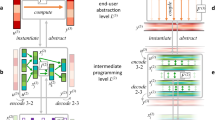Abstract
This paper presents a mathematical model for a mechanical computer called the Turing Tumble. We show that our model called Turing Tumble Model (TTM) is computationally universal under the assumptions that a configuration of TTM is sufficiently large and that local interactions between elements can be transferred without limitations. The Turing Tumble has a strict constraint, based on gravity, since signals can only move from top to bottom. We introduce a uniform scheme that takes into account this restriction in directionality to construct universal machines in the TTM based on directed acyclic graphs. This model may be useful for implementing computers that exploit mechanical interactions in nature, especially those on micrometer-scales.















Similar content being viewed by others
References
Hagiya M, Wang S, Kawamata I, Murata S, Isokawa T, Peper F, Imai K (2014) On DNA-based gellular automata. In: Proceedings of the 13th international conference on unconventional computation and natural computation, pp 177–189
Lee J, Yang RL, Morita K (2012) Design of 1-tape 2-symbol reversible Turing machines based on reversible logic elements. Theor Comput Sci 460:78–88. https://doi.org/10.1016/j.tcs.2012.07.027
Murata S, Konagaya A, Kobayashi S, Saito H, Hagiya M (2013) Molecular robotics: a new paradigm for artifacts. New Gener Comput 31(1):27–45. https://doi.org/10.1007/s00354-012-0121-z
Rondelez Y (2012) Competition for catalytic resources alters biological network dynamics. Phys Rev Lett 108(1):018102
Tang MX, Lee J, Morita K (2015) General design of reversible sequential machines based on reversible logic elements. Theor Comput Sci 568:19–27. https://doi.org/10.1016/j.tcs.2014.11.032
Tomita T, Lee J, Isokawa T, Peper F, Yumoto T, Kamiura N (2018) Constructing reversible logic elements on Turing Tumble model. In: Proceedings of 24th IFIP WG 1.5 international workshop on cellular automata and discrete complex systems (AUTOMATA2018), pp 33–40
Acknowledgements
We would like to thank the anonymous reviewers for their useful comments. This work was partially supported by the National Key R&D Program of China 2018YFD1100300.
Author information
Authors and Affiliations
Corresponding author
Additional information
Publisher's Note
Springer Nature remains neutral with regard to jurisdictional claims in published maps and institutional affiliations.
Rights and permissions
About this article
Cite this article
Tomita, T., Lee, J., Isokawa, T. et al. Universal logic elements constructed on the Turing Tumble. Nat Comput 19, 787–795 (2020). https://doi.org/10.1007/s11047-019-09760-8
Published:
Issue Date:
DOI: https://doi.org/10.1007/s11047-019-09760-8




